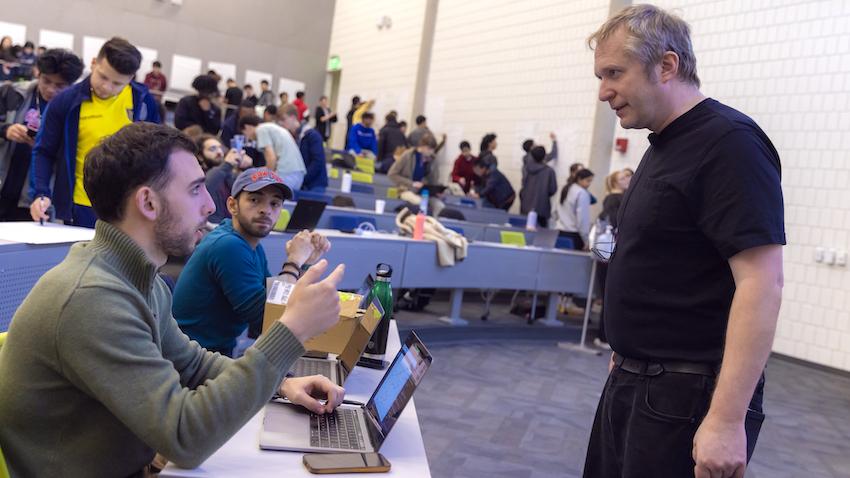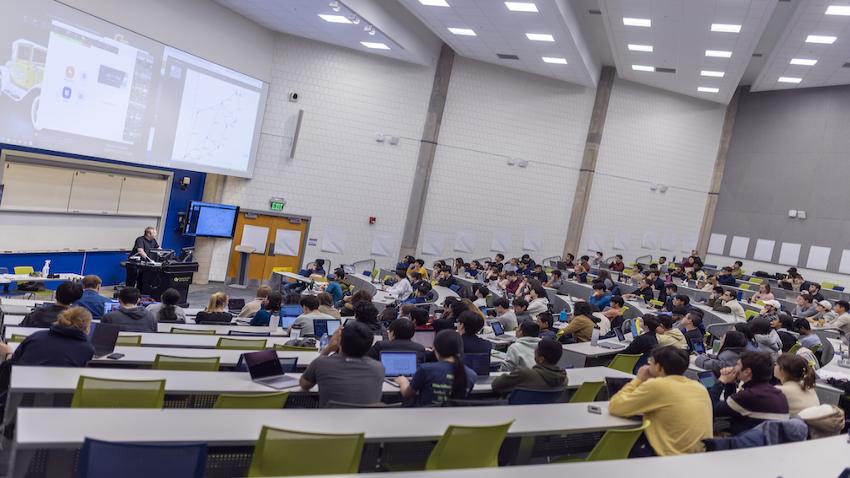
Professor Deploying Anti-plagiarism Detection Tool on 900-student Course
Interactive Computing professor Thad Starner is teaching one of the largest courses ever taught at the College of Computing. Introduction to Artificial Intelligence (CS3600) has 911 students taking the course for Spring 2023.
To manage a class that size, Starner is using nine classrooms and 18 teaching assistants to livestream his lectures.
But the biggest concern he has for the course isn’t logistics — it’s the difficulty of tracking plagiarism.
According to a study conducted by Plagiarism.org, 38 percent of college undergraduates said they committed plagiarism at least once. Starner said the first time he tracked plagiarism in his masters-level AI course, he found a rate of 7 percent, which means he can expect at least 60 students from CS3600 to cheat at some point this semester.
Starner added that if a professor takes preventative measures, such as giving a plagiarism exam, the rate is cut in half.
But Starner is going beyond that. He’s created AI-driven anti-plagiarism software that can automatically detect when students are colluding or sharing answers and when students are trying to outsource their homework to freelancers over the internet.
“This is the first time we’ll be able to use our anti-plagiarism tool on a class this size at the undergraduate level,” Starner said. “We want to make students aware that we’re doing it to take away the impetus to cheat and give the system a good test.”
Starner said the idea for his anti-plagiarism tool began when he taught Artificial Intelligence (CS6601) as part of the Online Masters of Science Computer Science in 2016. A professor from Portugal, who at the time freelanced as an online tutor, contacted Starner to make him aware one of Starner’s students tried to hire him to complete a take-home exam.
“The idea that someone would actually hire a consultant to do their take-home exam for them is so far beyond what I would consider to be normal cheating,” Starner said.
“During Covid, suddenly a lot of things were take-home. My courses were all take-home exams and assignments that last two weeks. We really need to make sure we maintain the integrity of the program. So, we started to look to see if we could have automatic tools that could identify when people were sharing answers on exams or assignments and could help us figure out when people are searching for freelancers to do their work for them.”

In the Fall 2022 semester, Starner used a new tool on a live class for the first time when he taught Mobile and Ubiquitous Computing (CS4605), which had an enrollment of slightly more than 100 students.
“The system works,” Starner said. “We went after the most egregious cases — people we believe shared information on both the midterm and final. What we found out is that all the ones we went after admitted to it.”
For any assignment or exam that involves writing code, the tool can automatically list and compare one student’s code to another and look for the codes that are most similar.
“When you have a thousand students, you can compare every student to every other student and get some sort of metric of how close their code is,” Starner said. “You look for the ones that are way too similar. Our automatic tools help us focus our attention to the cases that are most interesting.”
For CS3600, Starner hopes that his new tool sends the message that cheaters will be caught and encourages anyone who would have cheated to drop the course.
Inevitably, Starner knows his tool won’t eliminate every instance of plagiarism. That’s why he added an additional feature that will help automate the process of working with the Office of Student Integrity to prosecute cases. The tool can automatically gather evidence and send its findings to OSI, reducing a process that would normally take days or weeks into minutes.
“That’s a lot of burden on the professor to push those through, but once students know you’re doing this, they realize it’s much easier to learn the material than it is to cheat,” he said. “The number of cases goes down if the effort goes down, but you still have enough cases that it’s going to take a lot of time. We’ve got to really make that convenient for professors to do.”
Starner said he’s already started integrating his anti-plagiarism tool with Canvas, the web-based learning management system the Institute uses to create and manage online courses.
“We want to make it so that anybody who has a Canvas quiz, you can click a button, and it will immediately give you the most similar exams that have the highest probability of plagiarism.”
In addition to the anti-plagiarism tool, Starner said he has a group of teaching assistants for CS3600 dedicated to monitoring plagiarism.
The message is clear.
“Don’t cheat,” Starner said. “We’re trying to make it so that it’s just as hard to cheat and not get caught as it is to do the work in the first place, so just do the work in the first place.”


